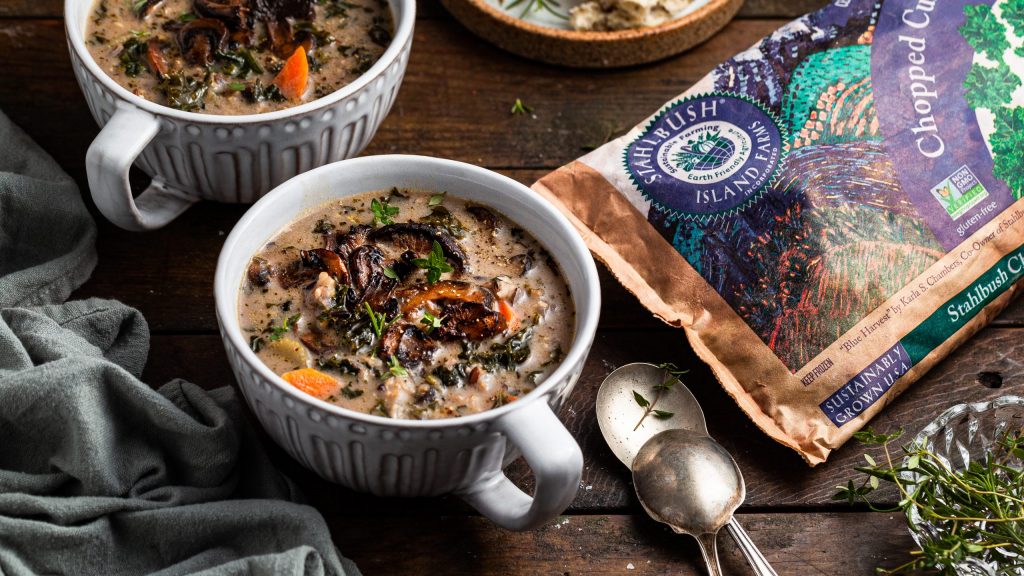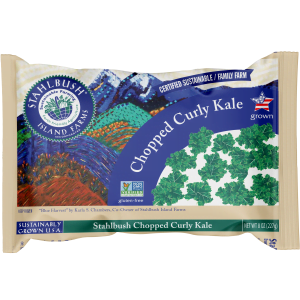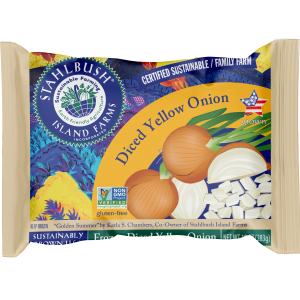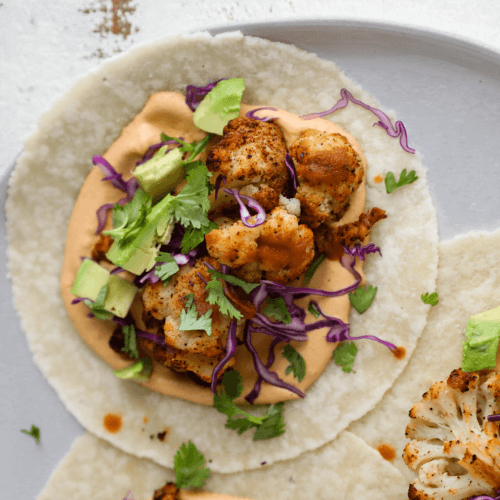Mushroom Wild Rice Soup

INGREDIENTS
- 7 tbsp extra-virgin olive oil, divided
- 14 oz mushrooms*, sliced (approximately 6 cups sliced)
- 2 tbsp balsamic vinegar
- 1 brown onion, diced
- 4 cloves garlic, minced
- 1 tsp dried thyme
- 1 tsp dried oregano
- 1/2 tsp dried rosemary, chopped
- 1/4 tsp powdered/ground sage
- 1/2 cup white wine (may use vegan broth instead)
- 1/3 cup all-purpose flour (or 1:1 all-purpose gluten-free flour blend)
- 5 cups vegan soup stock/broth (or 5 cups water + 2 beef-style vegan bouillon cubes)
- 1 1/2 cups vegan unsweetened milk (I use soy or oat. Avoid rice milk which is quite thin.)
- 2 celery stalks, sliced (~ 2/3 cup)
- 2 carrots, diced or cut into half-moons (~1 cup)
- 1 cup wild rice blend
- 1 bag Stahlbush Island Farms frozen chopped kale
- salt and pepper to taste
INSTRUCTIONS
To Make on the Stovetop:
- In a heavy bottomed pot or 3-5 quart Dutch oven, heat 2 tablespoons (30 mL) of oil over medium-high heat. When shimmering, add the mushrooms and cook for 8-9 minutes, or until cooked and caramelized in spots. Add the balsamic vinegar, cooking for another few minutes or until the moisture has mostly evaporated and the mushrooms are glazed. Place the mushrooms on a plate for later.
- Reduce the heat to medium, and add the remaining 5 tablespoons (75 mL) of oil. When shimmering, add the onions. Cook until softened, 2-3 minutes. Add the garlic, thyme, oregano, rosemary and sage, cooking for 30 seconds. Deglaze with the wine (or equal amount of broth), cooking until most of the moisture is cooked off.
- Sprinkle in the flour, stirring frequently for 2 minutes to cook the flour. Pour in 2 cups (500 mL) of broth, whisking constantly to prevent flour lumps from forming, until the mixture thickens.
- Add the rest of the broth, dairy-free milk, celery, carrots, and rice and bring to a simmer. Cover and cook for as long as directed on the rice package – this will vary depending on the blend you’re using.
- At the end of cooking, add the kale. Cook for 2-3 minutes until the kale is bright and softened. Stir the mushrooms back into the pot. Add salt and pepper to taste. Serve immediately.
To Make in the Instant Pot:
- Set a 6-quart (or larger) Instant Pot** to Sauté ,and add 2 tablespoons (30 mL) of oil. When shimmering, add the mushrooms and cook for 8-9 minutes, or until cooked and caramelized in spots. Add the balsamic vinegar, cooking for another few minutes or until the moisture has mostly evaporated and the mushrooms are glazed. Place the mushrooms on a plate for later.
- Add the remaining 5 tablespoons (75 mL) of oil. When shimmering, add the onions. Cook until softened, 2-3 minutes. Add the garlic, thyme, oregano, rosemary and sage, cooking for 30 seconds. Deglaze with the wine (or equal amount of broth), cooking until most of the moisture is cooked off.
- Sprinkle in the flour, stirring frequently for 2 minutes to cook the flour. Pour in 2 cups (500 mL) of broth, whisking constantly to prevent flour lumps from forming, until the mixture thickens.
- Add the rest of the broth, dairy-free milk, celery, carrots, and rice.
- Lock the lid of the Instant Pot. Place the pressure release vent to the “Sealing” position. Cook on High Pressure for 20 minutes.
- At the end of cooking, do a natural pressure release for 5 minutes then do a quick release by manually venting the remaining steam from the Instant Pot (set the valve to “Venting”) – watch out for the very hot steam. Once the pressure button goes down, remove the lid. Set to Sauté, add the kale. Cook for 2-3 minutes until the kale is bright and softened. Stir the mushrooms back into the pot. Add salt and pepper to taste. Serve immediately.
Notes:
*use any mushrooms you like. Creminis (baby portabellas) have a richer flavor than button mushrooms. I like to use a blend of creminis and shiitakes.
**To make this soup in the 3 quart mini Instant Pot, divide the recipe in half but the cooking time will be the same.
Storage, Freezing and Reheating:
As this soup contains rice (which requires special care in terms of food safety), it needs to be refrigerated within an hour of cooking and cooled quickly – to do this, use shallow containers and don’t stack them. It’s best to eat the leftovers within 3-4 days of making the soup.
Featured Products
Explore More
Copyright 2025 Stahlbush Island Farms.
Website Design and Maintanance by Abide Web Design.






